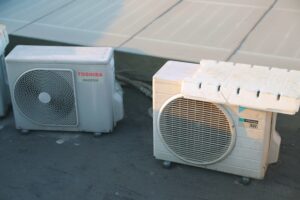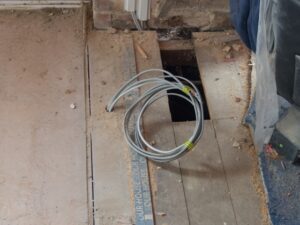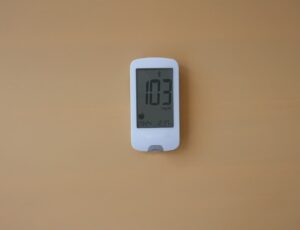Ever wished you could adjust the temperature of each room in your home or office exactly the way you want it?
Zoned heating and cooling systems make that possible, giving you full control over the temperature of different areas independently. This not only boosts your comfort but can also lower your energy costs by ensuring you’re only heating or cooling the spaces you’re using.
At Excel Mechanical, we specialize in providing the ideal zoned system for your specific space and lifestyle. We know every home and business has unique needs and budgets, so we offer solutions to maximize efficiency and comfort.
Whether you need a personalized system for your home or business, we’re here to ensure your environment is perfectly managed, all while keeping your costs in check.
Choosing the right professionals for your zoned system is essential. With Excel Mechanical, you get the expertise that makes managing your indoor climate effortless. We’re committed to superior service and customer satisfaction, ensuring you enjoy an energy-efficient and comfortable system.
In this blog, we will cover:
- The fundamentals of zoned heating and cooling systems.
- The benefits of implementing a zoned system for your space.
- Expert tips for designing and optimizing a zoned HVAC system.
Let’s find it out!
Fundamentals of Zoned Heating and Cooling
Zoned heating and cooling systems allow for precise temperature control across different areas of your home or building. By dividing spaces into distinct zones, these systems enable individualized climate settings for maximum comfort and energy efficiency.
Definition and Principles
Zoned heating and cooling involve splitting a building into different zones; each controlled independently using thermostats. This allows temperatures to be set according to the specific requirements of each zone, for example, keeping bedrooms cooler while making living areas warmer.
Key Principles:
- Individual Control: Separate thermostats let you adjust the temperature in each zone.
- Energy Efficiency: Only by heating or cooling areas in use is energy consumption reduced.
- Customization: Each zone can be customized based on usage patterns and occupants’ preferences.
This method maximizes comfort and minimizes waste, offering a smart way to manage your HVAC system.
Components and Mechanisms
A zoned heating and cooling system typically includes a central HVAC unit, zone dampers in the ductwork, and multiple thermostats. The dampers open or close to direct airflow to the designated areas when needed.
- Thermostats: These devices control the climate in each zone, allowing for personalized temperature settings.
- Dampers: Motorized dampers adjust airflow, directing it to specific zones based on your settings.
- Control Panel: It integrates all components, allowing them to communicate and function effectively.
Our team specializes in HVAC services and delivers top-notch solutions for residential and commercial settings. Our expertise and commitment to quality make us the best choice for zoned heating and cooling systems.
Benefits of Zoned Systems
Zoned heating and cooling systems provide tailored temperature control in different areas of your home or building. This approach enhances energy efficiency, comfort, and climate control in specific zones.
Energy Efficiency
Zoned systems help you save energy by allowing targeted heating or cooling.
Instead of running a central system throughout the building, you can focus on specific areas. This reduces energy consumption, as you only use what you need.
Imagine heating only the living room during the evening and cooling the bedrooms at night. This precise control minimizes waste and lowers energy bills.
Customized Comfort
Zoned systems allow you to set different temperatures in various zones according to personal preferences. This feature is especially useful in homes with multiple occupants who prefer different temperatures.
By using programmable thermostats, you can customize the climate in each room. This ensures everyone is comfortable without compromising on energy use.
Enhanced Climate Control
Zoned heating and cooling provide enhanced climate control in your home. You can precisely manage the temperature, addressing hot or cold spots effectively. It also helps in dealing with different requirements for sunlit and shaded areas.
With advanced technology, including smart thermostats, adjustments can be made remotely conveniently. This ensures every area remains at the desired temperature, enhancing overall indoor comfort.
Designing a Zoned System
Designing a zoned heating and cooling system involves careful planning and choosing suitable equipment for efficient climate control. Proper installation ensures optimal performance.
Planning and Layout
First, consider how many zones your space needs.
A zone is a specific area with its thermostat. More zones mean more control but could increase complexity. Think about areas that have different temperature needs. For example, a sunny room might require different settings than a shaded one.
Create a detailed floor plan. Label each zone clearly. Indicate where thermostats, vents, and dampers will be. This helps visualize the system and ensures complete coverage.
Remember, the goal is to maintain comfort in each zone.
Selecting the Right Equipment
Choose equipment that matches your heating and cooling needs.
Variable speed systems can be more energy-efficient. Look for compatible smart thermostats. They offer precise control and access through mobile devices. Selecting the correct size of HVAC units avoids unnecessary energy use and effectively maintains comfort.
Use energy-efficient units to lower utility bills. Excel Mechanical provides professional advice on selecting the right HVAC system for residential and commercial spaces. We focus on quality and affordability, ensuring you get the best value.
Installation Considerations
Proper installation is vital for the system’s success.
Ensure all ductwork is sealed and insulated. This prevents air leaks and maintains efficiency. The placement of thermostats and sensors is also crucial; they should be in a location that accurately represents the zone’s temperature.
Work with experts to avoid costly mistakes.
Control Technologies
Efficient zoned heating and cooling systems rely heavily on advanced control technologies. These technologies provide precise temperature management for different areas, enhancing comfort and energy efficiency.
Thermostats and Sensors
Modern thermostats are the heart of zoned systems.
They let you set different temperatures for each room, ensuring personalized comfort.
Digital thermostats use sensors to monitor real-time temperature, adjusting the HVAC system. Some systems even feature occupancy sensors that detect movement, optimizing energy use by reducing heating or cooling when a room is empty.
Our team offers expert installation of these advanced thermostats with precision and reliability. Our systems can help you achieve your desired comfort efficiently, ensuring you get the best from your heating and cooling system.
Smart Home Integration
Smart home integration takes zoned heating and cooling to the next level.
Systems connect with smart home platforms like Amazon Alexa, Google Assistant, or Apple HomeKit, empowering you to control your HVAC settings through voice commands or smartphone apps. This allows adjustments anytime, even when you’re away from home.
These systems are designed to improve your comfort and convenience. You can trust us to equip you with technology that suits your lifestyle while ensuring top-notch performance and reliability for residential or commercial spaces.
System Optimization
Optimizing your heating and cooling system means keeping it running smoothly and ensuring it meets your needs. Regular maintenance and timely troubleshooting are key to achieving precise control and efficiency.
Maintenance and Upkeep
Regular maintenance keeps your system efficient and extends its lifespan.
- Basic tasks like replacing filters every 1-3 months are crucial.
- Clean filters allow airflow and prevent the system from overworking.
- Annual check-ups by professionals catch potential issues early.
- At each visit, experts inspect components, calibrate equipment, and clean key parts.
- In doing so, they ensure the system works at peak performance.
Troubleshooting Common Issues
Troubleshooting helps identify and fix problems before they escalate.
Common issues include uneven heating or cooling and strange noises, which can often be solved with minor adjustments.
For example, uneven temperatures might be due to blocked vents or faulty thermostats. Ensuring vents are open and checking thermostat settings can help. If the problems persist, you might need more expert assistance.
Strange noises often signal a need for part replacement or repair.
Address these sounds quickly to avoid bigger issues.
Case Studies
Zoned heating and cooling can significantly improve energy efficiency and comfort. Here are examples of how this technology has been used in various settings.
Residential Applications
Zoned heating and cooling systems are increasingly popular in residential homes where energy efficiency and comfort are priorities.
Homeowners often face the challenge of uneven temperatures across different rooms. By installing zones, specific areas can be controlled separately. This way, you can direct heating or cooling only where needed, saving on energy bills.
For instance, using a zoned system, you can keep bedrooms cooler at night while maintaining a warmer living room during the day. This flexible control makes homes much more comfortable.
Commercial Implementation
Zoned heating and cooling in commercial buildings can provide significant energy savings and enhanced comfort.
Workspaces, meeting rooms, and common areas may require different temperature settings throughout the day. Zoned systems allow you to adjust these settings based on occupancy and usage.
Such systems are very effective for large offices or multi-story buildings. They adapt to the needs of specific areas without wasting energy. The goal is to optimize energy use while keeping staff comfortable.
Environmental Impact
Zoned heating and cooling systems can significantly reduce energy usage and support sustainable living. They provide precise control and lower energy consumption, offering environmental and economic benefits.
Reducing Carbon Footprint
Using zoned heating and cooling, you can target specific areas of your home or building to heat or cool. This avoids wasting energy on unoccupied spaces. When less energy is used, greenhouse gas emissions decrease, reducing your carbon footprint.
According to the U.S. Department of Energy, heating and cooling account for nearly half of a typical home’s energy use. Zoned systems can potentially lower this use by up to 30%.
Using less energy contributes positively to the environment by reducing demand for fossil fuels and decreasing air pollution.
Sustainable Practices
Zoned systems offer an efficient way to practice sustainability.
These systems allow the integration of smart thermostats and energy-efficient HVAC units, which work together to optimize energy use. This smart integration means the system can adjust based on environmental factors, ensuring minimal energy waste and maximum comfort.
Our solutions merge exceptional quality with great value. Whether for residential or commercial properties, we provide the most suitable and efficient system to fit your budget and environmental aspirations.
Our expertise and dedication make us a top choice for HVAC and plumbing services.
Regulatory and Standards Compliance
Complying with regulations and standards is vital when setting up zoned heating and cooling systems. These standards ensure systems operate efficiently and safely.
Key Standards
- ASHRAE Standards: They set guidelines on energy efficiency, indoor air quality, and comfort.
- EPA Guidelines: Focus on environmental impacts and energy savings.
- Local Building Codes: Each area may have its own codes. Adhering to them ensures the system is legally compliant.
Compliance Benefits
Following regulations means safer and more efficient systems. It also avoids potential fines and increases system lifespan.
Choosing the Right Professionals
At Excel Mechanical, we prioritize these standards in every installation. Our team understands each regulation to ensure perfect compliance. Our expertise guarantees top-quality systems suited to your needs and budget, whether for residential or commercial. Our team delivers exceptional quality and value, making us the best choice for HVAC and plumbing needs.
Economic Considerations
Zoned heating and cooling systems can offer financial benefits by improving energy efficiency. You’ll find ways to lower energy costs and take advantage of incentives that make these systems more affordable.
Cost-Benefit Analysis
Zoned heating and cooling systems require a higher initial investment than traditional HVAC setups.
Costs include equipment, installation, and potential upgrades. Meanwhile, benefits involve reduced energy waste since you control temperatures in specific areas rather than the whole home or building.
A potential savings of 20-30% on energy bills makes the investment worthwhile. The system targets heating and cooling only in occupied zones, saving energy. You might recover costs within a few years, especially in larger homes or businesses.
Choosing a reliable service provider is crucial.
Incentives and Rebates
Various incentives and rebates can make zoned systems more accessible.
Federal, state, and local programs often offer support for installing energy-efficient systems. These can significantly lower the overall cost.
Tax credits can reduce your tax liability, providing additional savings. Utilities sometimes offer rebates for upgrading to a zoned system. These programs vary greatly by location, so it’s worth checking available options when planning your installation.
Excel Mechanical has experience navigating these offers, ensuring you receive any available financial benefits. We can guide you through the process, making the transition to zoned heating and cooling more affordable.
Frequently Asked Questions
Got questions about zoned heating and cooling systems? We’ve got answers! Whether you’re wondering about costs, how the system works, or what makes it stand out from traditional HVAC setups, we’re here to help you understand everything you need to know to make an informed decision. Let’s dive into some of the most common questions we get asked.
How much does it typically cost to install a zoned HVAC system?
The cost of installing a zoned HVAC system varies based on factors like the size of your home and the system’s complexity. On average, costs can range from $2,500 to $5,000. Consulting experts like those at Excel Mechanical can provide an accurate estimate for your specific needs.
What are the benefits of installing a zoned heating and cooling system?
Zoned systems let you heat or cool specific areas of your home independently, enhancing comfort and saving energy. You can adjust temperatures in different zones to suit various needs, leading to improved efficiency and reduced utility bills over time.
Can you heat and cool different zones simultaneously with a zoned HVAC system?
Yes, a zoned HVAC system allows for simultaneous heating and cooling in different zones. This means you can customize the climate in different parts of your home or business to suit varying preferences and needs, maximizing comfort and flexibility.
What distinguishes zoned heating and cooling from traditional central HVAC systems?
The main difference is control. Traditional systems heat or cool the entire space uniformly, while zoned systems target specific areas independently. This feature makes zoned systems more versatile and energy-efficient, as you can adjust temperatures based on the usage of each area.
What should one consider when choosing the best-zoned heating and cooling system?
When selecting a zoned system, consider your space’s size and layout, budget, and specific comfort needs. Excel Mechanical can help guide you through these considerations, ensuring you get a system that fits perfectly with your requirements and delivers value.
How does a zone control system work within a residential HVAC setup?
A zone control system operates using dampers in the ductwork and a series of thermostats. These components direct airflow to different zones based on set temperatures. This allows for customized heating and cooling, providing comfort where and when needed.




